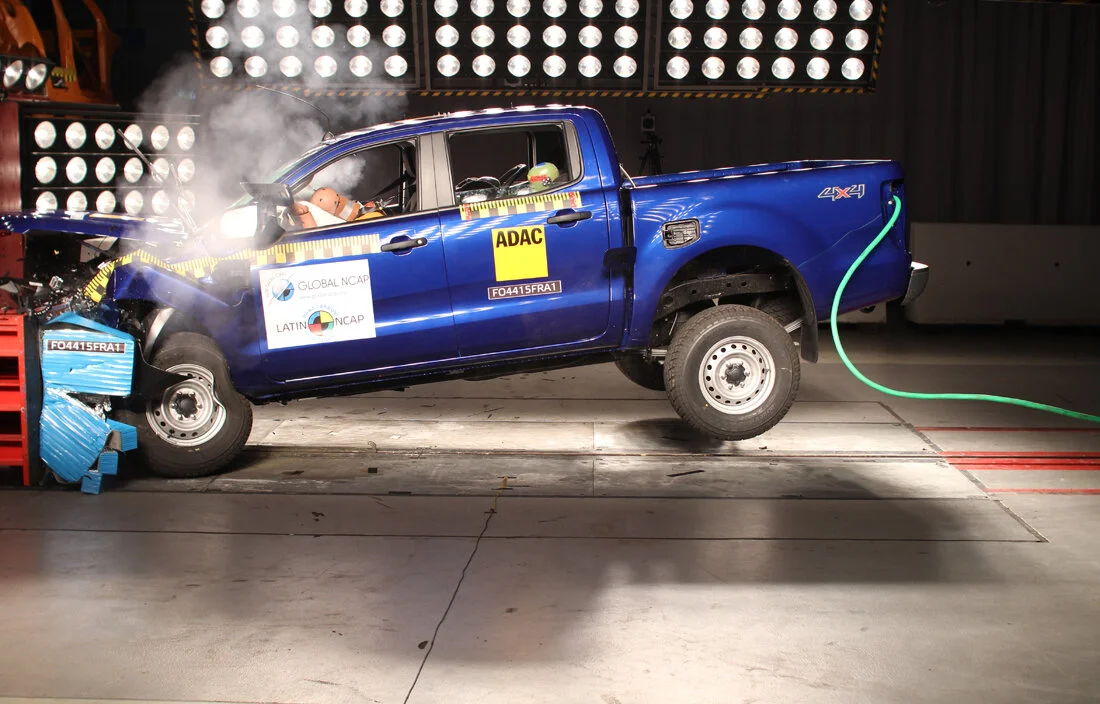Another Zero Star Chevrolet And The Ford Ranger Scores Three Stars For Adult Occupants
The latest crash test results of the New Car Assessment Programme for Latin America and the Caribbean, Latin NCAP, continue to reveal life threatening safety results from some car manufacturers as well as progress from others. These results are the first to be tested under the new and tougher protocol introduced at the end of last year. The results show the Ford Ranger pick-up reaching three stars in Adult Occupant Protection and a disappointing Adult Occupant Protection zero stars for the Chevrolet Sail.
The Chevrolet Sail is a popular compact sedan for the Latin American market. The unit that was tested is produced in China and assembled in Colombia. The Sail scored zero stars in Adult Occupant Protection and two stars in Child Occupant Protection. The structure of this car was rated as unstable and it will not be able to withstand further loadings. The driver registered high risk of life threatening injuries in the head and in the chest. The passenger’s chest showed compression close to the allowed limit. The driver injuries explain the zero stars and for this reason the side impact was not performed by Latin NCAP as the result will keep being zero stars for adult occupant protection. The Sail offers ISOFIX anchorages for child restraint systems that were used for the test that in combination with the child seats, offered a reasonable protection to the child occupants. However the Sail does not offer 3 point belts in all positions which prevents the car from earning points from other features like ISOFIX anchorages. The installation instructions for proper positions of the child seats made the Sail to lose points as well.
The recently launched New Ford Ranger produced in Argentina, offered three stars Adult Occupant Protection and four stars in Child Occupant Protection. The pick up was submitted to frontal and side impact tests and in both cases it offered good Adult and Child Occupant Protection. The Ranger offers ISOFIX anchorages, three point belts in all seating positions and airbag disabling switch used when a rearward-facing seat is installed in front of the passenger airbag. Unfortunately, the Ranger does not offer Electronic Stability Control (ESC) as standard meeting Latin NCAP’s requirements, and the side pole impact test was not performed, these two aspects explain why the Ranger could not achieve a higher star rating score for adult occupant protection.
María Fernanda Rodríguez, Latin NCAP President said: “I’m shocked that we keep finding zero star Chevrolets in the Latin American market. Whilst other manufactures have shown improvement over the course of the last five years, GM models continue to disappoint. Latin NCAP is committed to bring safer cars to Latin America and we will keep testing, informing consumers, and highlighting GM’s as well as other car manufacturer’s shortfalls until change is effected”.
Alejandro Furas, Latin NCAP Secretary General said: “Latin NCAP is concerned by the low safety levels offered by Chevrolet models that have been tested by Latin NCAP over the 5 years of the programme. Especially as Chevrolet offer good safety levels at affordable prices in other markets. Latin NCAP was further concerned after GM’s Mary Barra’s recent statements in Davos where she declined to commit to offer airbags as standard equipment for the Latin American consumers. Latin NCAP strongly encourages Chevrolet to follow Honda’s, Toyota’s or VW’s example, who all offer safety levels above the minimum governmental requirements in Latin America, as a market leader GM should be doing the same.”
Latin NCAP is pleased to announce that next results will be released in June.
New Assessment Protocols
In 2016 Latin NCAP has introduced a significant expansion of vehicles’ assessments. The requirements are now more demanding in order to achieve higher star ratings. Four and five star cars need to have ESC and pass its performance test. Five star cars are those that show good performance in frontal, side, and pole impacts and pass the ESC test. Four star cars have to show a good performance in frontal and side impacts and pass the ESC test. All models must also have a good performance in side impact in order to keep the same star rating level as in the previous protocol. Cars that show zero star performance in front or side impacts tests will score an overall of zero stars. The side impact now also has CRS installed and two child dummies as in the frontal test and are assessed in order to also check the protection given to child dummies in side impact.
About Latin NCAP
The Latin New Car Assessment Programme (Latin NCAP) was launched in 2010 to develop a regional system of independent crashworthiness and safety rating across Latin America and Caribbean (LAC). Latin NCAP replicates similar consumer testing programmes developed over the last thirty years in North America, Europe, Asia and Australia, and which have proved to be very effective in improving the safety of motor vehicles. Since 2010 Latin NCAP has published the results of more than fifty cars in six test phases.
Latin NCAP acknowledges the support received by the Global New Car Assessment Programme (Global NCAP), International Consumer Research and Testing (ICRT), FIA Foundation, the Inter-American Development Bank (IDB) and Bloomberg Philanthropies Global Road Safety Initiative.
Latin NCAP is an Associate member of Global NCAP and supports the United Nations Decade of Action for Road Safety 2011-2020 and the Stop the Crash Partnership.






